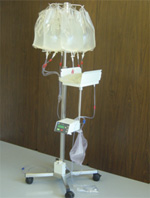 Our patented home peritoneal dialysis systems have led the way in advancing the art of peritoneal dialysis. Medionics was the first in the industry to design products that radically improved patients’ lifestyles. Medionics has long been recognized by hospitals and patients around the world as a leader in developing new products for the peritoneal dialysis industry. Our patented home peritoneal dialysis systems have led the way in advancing the art of peritoneal dialysis. Medionics was the first in the industry to design products that radically improved patients’ lifestyles. Medionics has long been recognized by hospitals and patients around the world as a leader in developing new products for the peritoneal dialysis industry.
We design and manufacture automated peritoneal dialysis (APD) machines and dialysis disposables for use by home patients around the world. We also manufacture a wide range of dialysis catheters and other vascular access devices for both peritoneal and hemo dialysis.
History of Innovation
| 1976 |
PDC 1000: Invented the world’s first solid-state peritoneal dialysis cycler with unique tri-state cycling and patented cam operation for independent tube occlusion. Independent fill state allows fluid intake adjustment from cycle to cycle during dialysis. Independent dwell period provides consistent dialysis treatment and ensures accurate results. Heating dialysate during both dwell and drain modes provides longer heating time to ensure better temperature regulation independent of drain time adjustments. Safety alarms for overnight treatment. Introduced in American Society of Artificial Internal Organs (ASAIO) Congress, San Francisco in 1976. |
 |
| 1980 |
PDH 100: First Portable Peritoneal Dialysis Solution Bag Heater. Reliable and accurate solid-state temperature control with over-heating protection provides gentle heating of the dialysis solution bags without changing their chemical composition. Provides space for two solution bags for alternate CAPD exchanges. |
 |
| 1983 |
Microstar VC-1: Invented the first Volumetric Cycler with Microprocessor and Effluent Detector. Introduced in ASAIO, Toronto in 1983. The volumetric concept becomes the industry standard for measurement of patient in-flow and out-flow, and is later adopted by all dialysis companies. Ultrafiltration measurements and recall features provide utmost in patient safety and reliability. |
 |
| 1987 |
QC Cap: Invented the Quick Connect (QC) Cap which speeds up patient on/off procedure, and for the first time enables easy interruption of dialysis treatment. Eliminates expensive prep kits. Significantly reduces risk of Peritonitis. Becomes industry standard for disconnecting peritoneal dialysis patients. |
 |
| 1988 |
CAPD “Y” Set: Invented the first low cost non-wearable "Y" System, which later becomes the industry norm. Needs no disinfecting at the end of an exchange. Combines the inherent advantages of “Y” set with the safety and flexibility of Medionics’ QC Cap to provide a truly unique disconnect CAPD “Y” system. Completely disposable. |
 |
| 1990 |
SELECTRA: Invented the first smallest and simplest APD machine for CAPD, IPD, CCPD, home or hospital use. May be used in Critical and Intensive Care Settings Uses Medionics' patented QC System for quick and easy patient connect and disconnect. Minimization of overnight glucose absorption. Flush before fill reduces peritonitis. Single push-button control. Gravity flow system for safe noise free operation. |
 |
| 1998 |
EASY CARE: Invented a truly revolutionary new system, which makes APD accessible and affordable to patients around the world by cutting down fluid costs dramatically. Improves CAPD weekly clearances and provides an ideal way to initiate incremental dialysis. Delivers prescription dialysis with the flexibility of day or night exchanges at convenience. Easy Care and its bag warmer together weigh only 3 kg providing true patient mobility. Introduced for the first time ever the concept of storing dialysis treatment data on a memory card in order to check patient compliance. |
 |
| 1999 |
Introduced top quality peritoneal dialysis catheters for treating patients suffering from end stage renal failure. These catheters provide acute or chronic access to the peritoneal cavity and are considered the lifeline of peritoneal dialysis. They are uniquely designed to improve dialysis efficiency and adequacy. |
 |
| 2002 |
Introduced arteriovenous shunts, vessel tips and accessories for providing another means of temporary access for hemodialysis treatment. They are used when neither subclavian nor femoral vein cannulation is feasible and need for hemodialysis is urgent. They can be used immediately after placement and require no needle puncture avoiding bleeding. |
 |
| 2005 |
Introduced top quality hemodialysis catheters for providing access to the blood vessels. Although arterio-venous fistula is the most preferred form of permanent access because
it is essentially free of infection, double lumen catheters continue to be a bridge to permanent access as the fistula matures. They are uniquely designed to improve dialysis efficiency and adequacy. |
 |
| |
|
|
| |
|
|
|